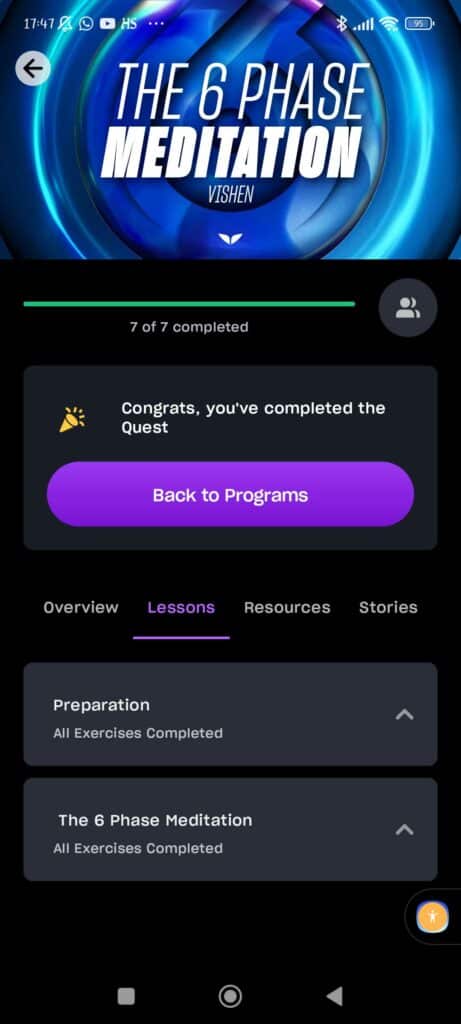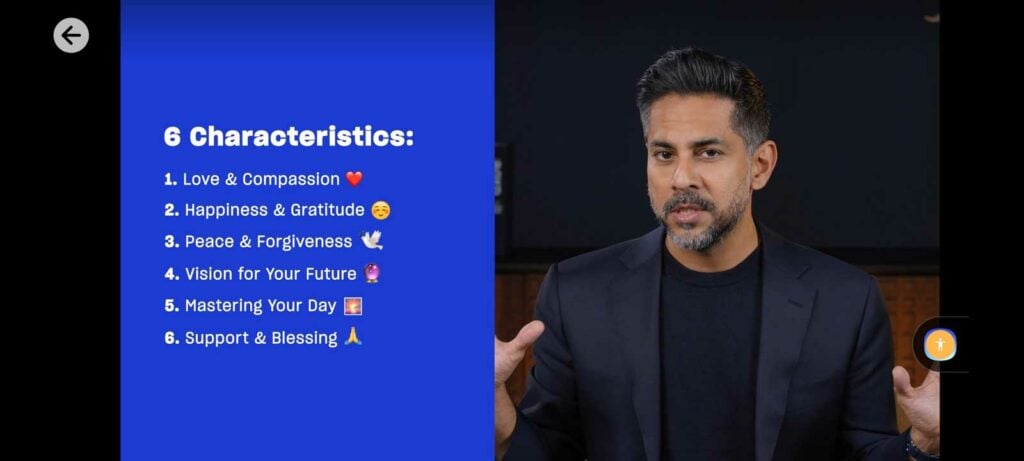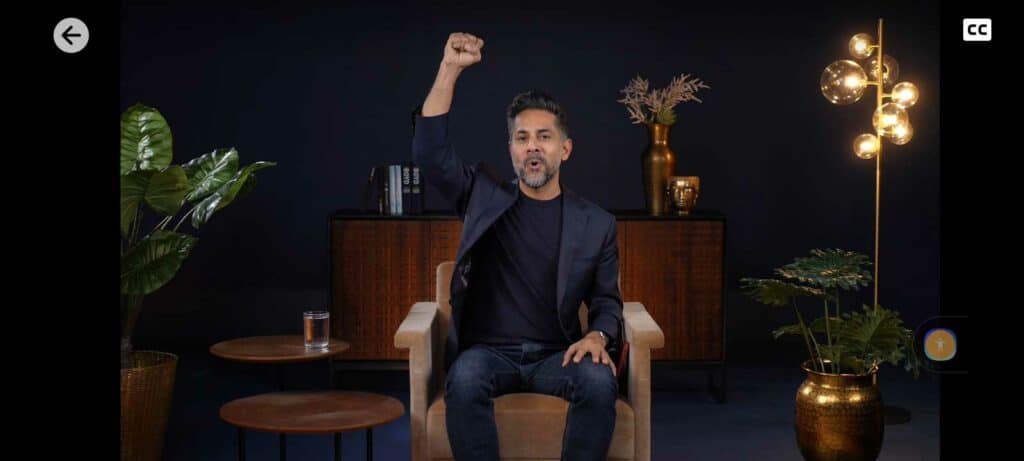I have a problem, and in this review, you’ll witness my attempt at solving it. I’ve been trying to incorporate meditation into my daily routine since 2017, committing to it with various levels of effort. My problem is that even though I’d like to meditate, I can’t find the peace of mind to sit down and do the work. My life is as scattered as anyone’s: I’m a restless mind with the obligations of a PhD student, a parent, a project researcher, a translator, a freelance writer, a boardgame geek, and a hobbyist clarinet player. I have a yoga and journaling routine, sort of, even though it often manifests as exercising and ranting.
What attracts me in meditation is the stillness of sitting with your mind. Stopping. Today, everybody knows that practicing meditation is likely to benefit you on all plateaus of your life. That’s what I want and what I find difficult to achieve. In this post, I provide a review of Vishen Lakhiani’s The 6 Phase Meditation on Mindvalley from this point of view: testing it as a person who is familiar with the theory of meditation but bad at practicing it.
You might think that this position invalidates me as a reviewer. False! In fact, Vishen Lakhiani, the founder of Mindvalley, states early on in the course that he created the 6 Phase Meditation for someone exactly like this. Not for a wannabe monk in their solitude on a water-fast retreat, but for a person with a life outside sitting cross-legged on a pillow.
In this review, I offer you an overview of the course, my experience of taking it, and some insights into the value I found in it.
Table of Contents
Technicalities: Accessing the quest in the Mindvalley app
The course can be accessed via Mindvalley – the website or the app – whichever is more convenient to you. The color scheme is dominated by an inviting shade of purply blue, and the videos are invariably of high quality. The overall impression is pleasant and streamlined.
If I was new to the platform, I could take the 20-or-so minute survey to find the programs that would be the best fit for me. But as I already know that I want to take the 6 Phase Mediation quest, I navigate to it with the search tool that works delightfully quickly and intuitively. This is the interface:

After locating the course, I am surprised to realize its short duration. The course, or quest, as they are called in the Mindvalley community, is no more than 2 hours and 7 minutes long, including three introductory sessions and seven program sessions. In real life, the length of the program, of course, adds up to more: most of the videos will be watched only once, but the final meditation, available in audio rather than video format, approximately 19 minutes in length, will be repeated multiple times.
I chose to take the quest on my phone using the app, and I found this to be a good solution. Relying on your phone, you can turn on the guided meditation wherever and whenever. So, this is the classroom – I’ll give a quick tour around the tabs before going into the content.
On the Overview tab, you’ll find the statistics of the course, information about Vishen Lakhiani himself, and a summary of the contents of the course. On the Lessons tab, you’ll find both the three preparatory videos and the seven program sessions. The Resources tab lists the audio files for each of the six phases of the meditation, as well as the seventh file that is the full meditation. On the Stories tab, you’ll find an extensive selection of inspirational stories uploaded to Mindvalley by the people who have completed the program.
In this review, I’ll remain on the Lessons tab, taking the curriculum of the program and reflecting on its contents. Let’s start with the introduction – the first three videos that help the student prepare for the 6 Phase Meditation routine.
Preparation: Meditation as a phenomenon
“I am not a big fan of meditation,” Vishen Lakhiani says within the first few seconds of the first video. He explains the difference between hermeneutic and transcendent meditation. Hermeneutic meditation is what we normally understand as meditation: anchoring the mind into the present through the act of breathing and the pursuit of weightlessness and clarity. This takes time and dates back in time. Therefore, Lakhiani explains, it’s not necessarily the best kind of meditation practice for the modern person. Transcendent meditation is what the 6 Phase Meditation represents; a practice that is not repeated for the sake of being consistent as such but for the sake of achieving a better version of yourself.
Lakhiani’s sales pitch is alluring: the 6 Phase Meditation is a program for the person who wants all the life-changing benefits of meditation, without any of the drawbacks. It’s not a meditation to explore the depths of your eternal soul for hours on end; it’s a method for optimizing the mind for the challenges introduced by the fragmented world we live in, all this in approximately 20 minutes a day.
The first video leaves me interested in the matter but, quite honestly, weirded out by the combination – the promise of spiritual growth is wrapped in a thick coating of strategic marketing. I’m being made aware that a bunch of top athletes, CEOs, politicians, and Hollywood stars practice and promote “the 6 Phase.” I don’t find this quite convincing and brush off the sales pitch as an unavoidable evil.
Moving on, the second video explains why the 6 Phase Meditation has these specific six phases and why they are in the order they are. The important thing to understand is that meditation is not a homogenous activity. There are multiple different ways to exercise, diet, or build a house. Similarly, there are multiple different ways to meditate. The 6 Phase Meditation is one of them.
Lakhiani refers back to his days working in scientific laboratories and brain research when explaining the positive effects of cultivating the states of the 6 Phase Meditation (never fear – I’ll go to these phases shortly). These states are “only emotions,” but they induce real, physical changes to the brain. Cultivating these emotions enhances the positive changes in the brain. Meditation, understood as it is in the 6 Phase Meditation, is re-wiring the brain to serve you better. It’s a way to optimize your hardware.
The third and final video is optional and meant for those who are new to meditation. It gives a thorough excursion into what the meditative state requires. Fitting the overall style and attitude of the 6 Phase Meditation, Lakhiani’s description is very pragmatic and accessible: the most important thing is to keep the practice simple and consistent and accept that disturbances – kids, spouses, the garbage man, your smartphone – may interrupt your practice, but that you simply find ways to get back to it. He demystifies, at least for me, some of the mysticism connected to the state of being meditative. It’s simply sitting with your thoughts and emotions.
Okay – with this knowledge added to quite some experience (albeit little success) in meditation, I am ready to move to the 6 Phase Meditation itself.
My journey through the 6 Phase Meditation program
The course is designed to be taken over the course of seven days. Each day, one more phase is introduced and added on top of the existing ones. Thus, on the first day, you’ll do phase one, on the second day, you’ll do phases one and two, and so on. After completing all six, the seventh day guides you to incorporate the full 6-Phase Meditation into your daily routine. The six phases are listed below:

The 6 Phase meditation is basically a path to the optimum frequency, like a map for your mind. The first three take you inwards: You look for resources in your memories, body, and emotions. The latter three are directed outwards: You take the resources you found within you and harness them to boost the manifesting power of your imagination. You connect the past to the future, positioned in the present. Let’s see how this works in practice.
Phase 1: Compassion
The phase of compassion guides you to think of someone you love. You tap into this love and then imagine its target disappearing from view. You are left with the love itself, the love they evoke in you, without restricting that love to that person alone. You imagine consciously spreading that love to, first, your immediate surroundings, to your house and city, and eventually, further, to your country and the entire world.
In essence, you draw on the love you feel easily for someone close to you, and then you extend that love to people unfamiliar to you and places unbeknownst to you, imagining that these people and these places would be as loved as you are by this person.
I tried thinking of the love I feel for my child, but to be honest, the relationship between a parent and a child is too complex to be all loving at all times (even though love invariably is there); there’s also fear, worry, and the will to protect them. So, I imagined my spouse. They are my rock. I imagined floating in this support that they always, invariably, and untiringly give me and how loved I feel because of that. Guided by Lakhiani, I imagined the same kind of encouraging support and acceptance being allocated to everyone and everything in my house, in my city, my country, my continent, and finally, envisioning the entire globe floating in space and being supported by this emotion.
It is likely that compassion does not mean the same for everyone, but this is what it meant to me. On the first day, this practice left me both smiling and feeling a bit silly. Embracing the world with your compassion can be a cheesy and grandiloquent activity to engage in, especially first thing in the morning. Yet, when I didn’t rationalize it too much, it started feeling, simply, nice. On the fourth day already, it felt totally natural.
Phase 2: Gratitude
The phase of gratitude guides you to be grateful for the things that bring happiness to you in life. First, you focus on the things in your personal life. You have memories of parties, embraces, laughs, jokes, smiles, lucky events. Remember these things, in the order they come to your mind, and feel the feelings that arise.
Continue to the things in your working life. Your work brings you joy, too – at least a payslip, but more likely also kind words from colleagues, inside jokes at the office, shared ambitions, or achieved success. Think about the memories that those elements of your working life are tied to, and relive them. Relive the happiness.
Finally, focus on the things about yourself that bring you happiness.
Lakhiani encourages you to be happy about yourself – the problem in the modern world is not too much but too little self-love, he stresses. Think about your skills and attributes that, perhaps, allow you to be useful to others or things that make you feel happy when you’re alone. Maybe you have a great imagination. Maybe you’re a great listener, or maybe you know everything there is to know about the X-Files. Live through the memories tied to the moments that made you aware of these traits.
I have a lot to be grateful for, and that alone is a thing to be grateful for. I have my family, my beautiful small home, my bookshelf, the cute shade of green of my yoga mat, and the fact that I had a package of fantastic coffee in the pantry. I found gratitude in my consistent salary, which, albeit coming from three different sources, always keeps me floating and allows me to enjoy life. I love my problem-free laptop and the new conference-call headphones.
Thinking about things I like about myself was, admittedly, more difficult. There, I still have work to do. Work that is probably connected to the third phase.
Phase 3: Forgiveness
In the phase of forgiveness, you think about something bad that has happened to you, something that was inflicted on you by someone else. After summoning the person responsible, feel the pain that their actions caused. To the extent you can, try to understand why they chose to do what they did. How did their perspective differ from yours? What in their life could have made it possible for them to see it as an option to hurt you? Were they hurt before? This practice does not mean that you should be freed from the pain right away.
You can repeat this practice as many times as you want over the days when you practice the 6 Phase Meditation. However, start making the difference between holding a grudge against them and holding them accountable. At some point, you should let go of the grudge, even forgive, while still acknowledging that it was their choice to hurt you, and thus they should be held accountable even if you can forgive them and will, eventually, be freed of the pain.
Forgiving the people who have wronged you can be easy if the things are clear-cut and perhaps happened only once or twice. However, I believe much of the grudge or sadness that we hold on to, and hold inside us, has happened over the course of years, sometimes decades. Neglectful or abusive parents, a marriage or relationship gone first stale and then toxic – those situations cannot be restricted into a clear set of events to go through. I, like most of us, have my share of these experiences.
What I chose to do here was to restrict the memory to singular events in which something bad happened, feel the pain of that situation, and try to understand the person’s motivations and perspective in that single, restricted setting without attempting to understand them as a person outside the situation. Forgiving just a little bit, even, felt very powerful.
Lakhiani says in the introduction to this phase that forgiveness is one of the strongest states of the mind to induce positive, physical changes in the brain. I believe that – the trip from pain to letting go of it is greater than the emotional trip in any of the previous (or upcoming) phases.
Phase 4: Your future self
In the fourth phase, you visualize your future self. The future self is you in a couple of years – more than one year but less than three. What do you want to be doing at that point? Do you want to look different, have a different job, a different home, or do you wish to have joined the New Rich and be a digital nomad? In this phase, no dream is too big. You should bring in all the senses and not only imagine the distant idea of a future you but make it concrete. What smells surround you? What have you just eaten? What do you see? What does the air feel like on your skin?
This is the fun part. I noticed that my future self was not the same every day, while many aspects did repeat. I found it the nicest to imagine a sequence of events, not just a picture of me existing in a location, but interacting with others, making things happen, and being happy in a way that showed through my body language, actions, words, and the look in my eyes.
The power of this exercise is supposed to be in making yourself believe that this version of you is achievable – you’re seeing them more and more clearly every day, and seeing is believing, right?
Phase 5: Your perfect day
In the fifth phase, you’re encouraged to imagine the day to come. This phase connects your long-term dreams to the next right steps to take toward them. You go through your day hour by hour, in as much detail as you like: what goals do you want to achieve, obviously, but also, who do you want to make happy today? How are you going to take care of yourself today?
Lakhiani asserts that it’s essential to understand that you can imagine everything going absolutely perfectly; there’s no need to be realistic. Imagine the best day of your life, from waking up to going to bed.
This phase was the most freeing to me. In my previous fumbling attempts at (what I now know is hermeneutic) meditation, I often got distracted and realized by namaste that I had floated into organizing my to-do list into pomodoro sessions instead of humming the mantra (side note: for a way to deal with distractions, see my review of Nir Eyal’s quest “Becoming Focused and Indistractable” – might come in handy for your meditative practice as well!). Here, I was instead allowed to allocate the time to go through the day!
I believe that this phase has a double effect, depending on how happy you are with your life. If going through the day hour by hour makes you wince, it is a good sign that something needs to be fixed. I noticed that this phase was very enjoyable also on a day off. It was extremely pleasant to descend into the decadent mist of idleness.
Phase 6: Asking for a blessing
In the final phase, you close the practice by connecting your visualization to something bigger or better than you. Whatever higher power or belief system you want to use works. This practice employs the idea of prayer, or asking for support or blessing, to provide closure to your practice.
In essence, the idea is to connect your intentions to the benevolent universe. Lakhiani introduces the ritual of the universal fist pump (visualized below), which ends the practice. You don’t have to do the fist pump if it makes you cringe, but maybe give it a try, at least! After the closing ritual of your choice, you open your eyes and start your day.

This phase does not take a lot of time. It contributes to the practice, however, if by no other means, then at least as a farewell to the promises you made to yourself during the practice. Like after a discussion with a friend, you say bye, or at the end of a presentation, people clap.
The 6 Phase Meditation is much like a discussion with yourself as a person you know and care about. I liked this aspect of it. It distinguishes the program from my previous attempts at meditation, which were more like trying to find myself somewhere I didn’t know I was. At the end of the practice, although my energy levels did vary from day to day, I invariably felt at least a little bit lighter, quite determined, and capable of having a good day.
Review: What is it good for, and for whom?
The way I saw this program was that it isolates these positive outcomes of the meditative practice in the spirit of fake it until you make it. In the first half of the practice, the emotional states of compassion, gratitude, and forgiveness are adopted as tools for a clearer, more loving mind that will, by the second half, be ready to harness this energy into a future you want to manifest for yourself. First, you dream big in phase four, and then you go practical in phase five, aiming to align each day with the long-term goal(s) you set in the fourth. At the end, you acknowledge that you are not alone. You’re guided and capable of manifesting the change you hope to see.
The difficulty of this relatively fast-paced meditation is that the feelings are evoked in a rather quick succession. The danger is that the emotions either drain you or that they feel somehow fake or diluted.
Lakhiani repeats phrases like “feel the feelings” as a way of helping you get deeper into the meditation. Sometimes that can feel forced as if you’d be expected to feel huge, earth-shattering emotions and just sit with them until jumping seamlessly to the next soul-crushing sensation.
I corrected for this by scaling the visuals of my memories down to what I was comfortable with that day. Feeling slight sadness or a bit of a tickle of joy was enough to make the practice feel meaningful and genuine. I don’t think anyone would willingly go through the emotional rollercoaster that this meditation would be, were the strength of the feelings a parameter of success.
The 6 Phase Meditation program is easy to customise to your varying moods per day, and once you give up the audio guidance, you can also vary the time you devote to each phase. Funny though, that the structure, at least to me, was so ingrained into my system that I didn’t feel comfortable skipping any of the phases, even when in a hurry.
I have found time to meditate after taking the course, even though I struggled to keep up the routine in the past. This is largely due to the fact that this kind of meditation – practical and straightforward – suits my restless mind. Lakhiani’s way of explaining the purpose of meditation as optimization lowers the threshold of sitting down to do the practice. I do not have to be totally still. I do not have to tap into my chakras. I simply settle into a comfortable position and feel the feelings that arise naturally, prompted by the specific themes, and then go on with my life.
The 6 Phase meditation is a program for optimizing your being – optimizing “the very act of being human,” as Lakhiani explains. I believe that anyone would benefit from trying this course, even if they’d realize afterward that hermeneutic meditation serves their interests best.
The 6 Phase Meditation is ingenious in its simple, inviting, low-effort starting point. You don’t have to be anything else than you are in order to improve your life with the program. The program itself does not require you to fix your lifestyle in any way before embarking on the quest.
At the same time, it does not provide you the tools for deeper self-exploration, either, in case that’s what you’d be looking for. With the 6 Phase Meditation, you work with what you’ve got: the limits of the practice are defined by your ability to be compassionate, to find things to be grateful for, and to be forgiving to those who wronged you – it does not really cultivate these skills if you don’t have them. At best, it makes you aware of the lack and, through that realization, introduces the spark to work on these qualities.
This is why, even if the program is simple enough for a beginner to enroll in, it might not ultimately be the most useful program for a beginner who’d be likely to benefit more from finding mental clarity on a more general level and by locating these mental resources. Without the readiness to tap into your compassion, gratitude, and forgiveness, the steps of imagining your future self and imagining your perfect day are more difficult to envision meaningfully. And these are the fun parts!
Allowing the mind to wander is my absolute favorite part of this program, and for someone who finds it difficult to still the mind in the traditional way, this is a great fit.
Next steps
If you want to get deeper into this method, you might want to also check out Vishen Lakhiani’s book on the topic. As a practice of optimization, the 6 Phase Meditation is strongly connected to different practices of manifestation, often spoken in the same breath with the notion of the Law of Attraction. This is one way forward from the 6 Phase Meditation. Mindvalley offers manifestation programs such as Be Extraordinary and The Silva Ultramind System, both quests delivered by Vishen Lakhiani himself. Over the last session of the 6 Phase Meditation, Lakhiani also recommends continuing to The 3 Most Important Questions, a short course by way of an introduction to the theme of manifesting through creative imagining.
However, the 6 Phase Meditation is a routine to be kept in and of itself. As for me, the benefits of sitting approximately 20 minutes per day, letting the mind wander back to memories and forward into plans and visions, have been noticeable. While I can identify a tiny spark of learning more about manifesting as a practice, for now, I settle for my own miracle of finding a meditation routine that I find possible to stick to.
Accessing the course
The 6 Phase Meditation is accessible through the Mindvalley Membership, which gives you access to all quests and learning communities on the platform. The cost for membership is $99 per month or $499 if paying for a year upfront (for a monthly cost of $41.60).
Membership comes with a no-questions-asked trial period of 15 days. The 6 Phase Meditation Quest can be completed in less time than that, so this is a great option to test out the platform for free.
Black Friday Special – get 40% off your Mindvalley Membership to get access to 100+ personal growth programs. Note that the discount is applied to the lifetime of your account – not just your first payment.




